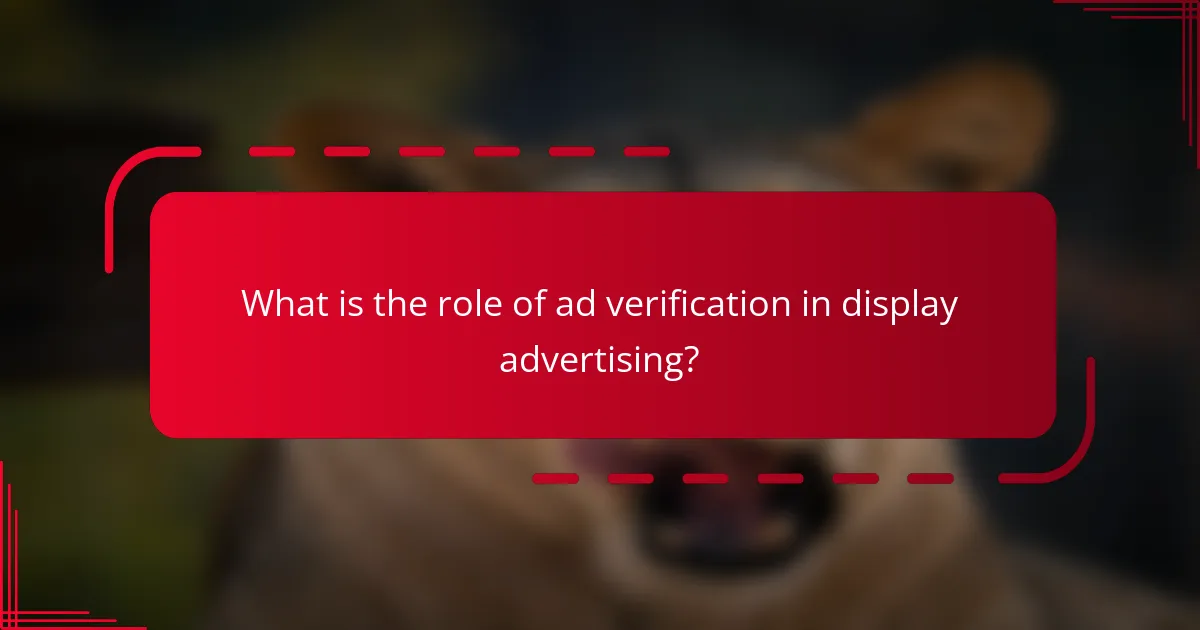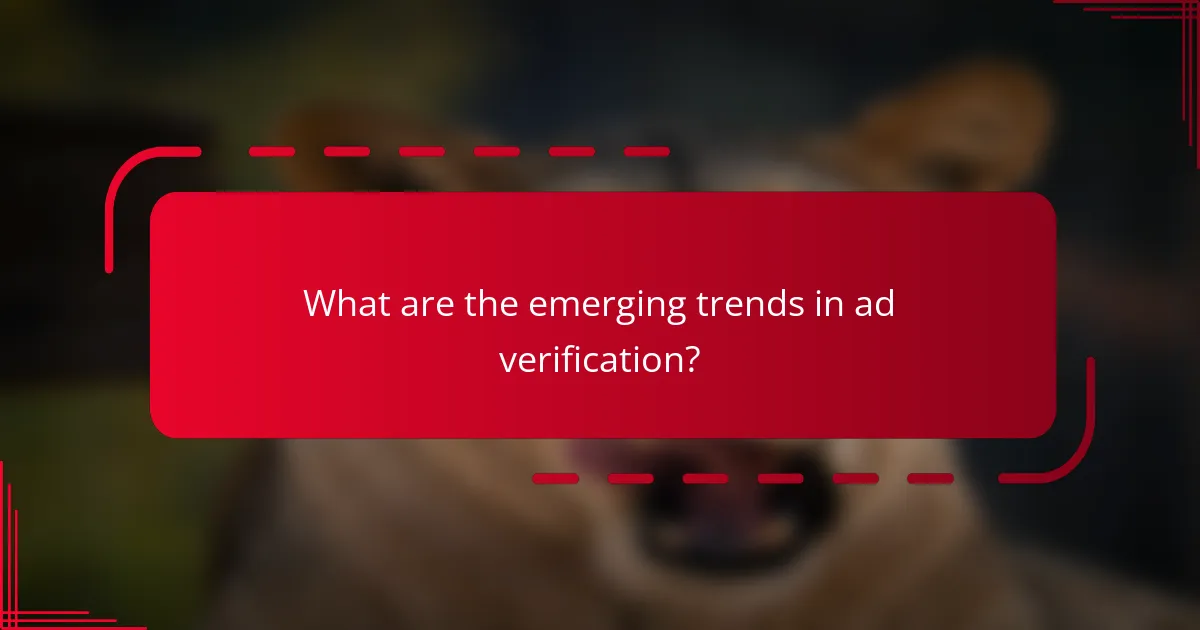Ad verification is essential in display advertising, ensuring that ads are shown as intended, in appropriate contexts, and are viewable by the target audience. This process not only protects brand reputation but also maximizes advertising effectiveness by confirming compliance with industry standards and regulations, thereby maintaining transparency and consumer trust.

What is the role of ad verification in display advertising?
Ad verification in display advertising ensures that ads appear as intended, in the right context, and are viewable by the target audience. It plays a crucial role in maintaining the integrity and effectiveness of advertising campaigns.
Ensures ad placement accuracy
Ad verification helps confirm that advertisements are displayed on the correct websites and in the appropriate formats. This process involves checking that ads are placed on sites that align with the brand’s values and target demographic.
For example, a luxury brand would want to avoid placements on low-quality or unrelated sites. By utilizing verification tools, advertisers can ensure their ads reach the intended audience in suitable environments.
Protects brand reputation
Maintaining a positive brand image is vital, and ad verification plays a key role in this. It prevents ads from appearing alongside inappropriate or harmful content, which could damage a brand’s reputation.
Brands can set parameters to avoid placements on sites with negative associations or controversial topics. This proactive approach helps safeguard against potential backlash and maintains consumer trust.
Enhances campaign effectiveness
Effective ad campaigns rely on accurate targeting and placement, both of which are supported by ad verification. By ensuring ads are seen by the right audience in the right context, advertisers can improve engagement and conversion rates.
For instance, campaigns that utilize verification services often see higher click-through rates, as ads are more likely to be viewed by interested consumers. This leads to better return on investment and overall campaign success.

Why is ad verification important for advertisers in the UK?
Ad verification is crucial for advertisers in the UK as it ensures that their ads are displayed in the right context, reaching the intended audience while minimizing risks. This process helps protect brand reputation and maximizes advertising effectiveness by confirming that ads meet specific standards and regulations.
Reduces ad fraud risks
Ad verification plays a vital role in reducing ad fraud risks by identifying and blocking fraudulent activities such as click fraud and impression fraud. By using verification tools, advertisers can ensure that their ads are only shown to real users, which helps in safeguarding their advertising budgets.
Common types of ad fraud include bot traffic and domain spoofing. Advertisers should regularly monitor their campaigns and utilize verification services to detect and mitigate these threats effectively.
Improves compliance with regulations
Compliance with advertising regulations is essential for maintaining trust and avoiding penalties. Ad verification helps advertisers in the UK adhere to standards set by bodies like the Advertising Standards Authority (ASA) and the UK Code of Non-broadcast Advertising and Direct & Promotional Marketing (CAP Code).
By ensuring that ads comply with these regulations, advertisers can avoid legal issues and protect their brand image. Regular audits and updates to verification processes can help maintain compliance as regulations evolve.
Boosts transparency in advertising
Transparency in advertising is enhanced through ad verification, which provides insights into where and how ads are displayed. This clarity helps advertisers understand the performance of their campaigns and the effectiveness of their ad placements.
Advertisers should seek verification solutions that offer detailed reporting and analytics. This data can inform future strategies and improve overall advertising outcomes by ensuring that investments are directed towards effective channels.

How does ad verification ensure compliance with industry standards?
Ad verification ensures compliance with industry standards by monitoring and validating digital advertisements against established guidelines and regulations. This process helps maintain transparency, protects consumer data, and ensures that ads are placed in safe environments.
Adheres to IAB guidelines
Ad verification tools are designed to adhere to the Interactive Advertising Bureau (IAB) guidelines, which outline best practices for digital advertising. These guidelines help ensure that ads are displayed correctly, reach the intended audience, and are free from fraud. By following IAB standards, advertisers can enhance their credibility and improve campaign performance.
For example, IAB guidelines specify acceptable ad formats and sizes, ensuring that ads are compliant with technical specifications. Regular audits against these standards can help identify any discrepancies early in the campaign.
Fulfills GDPR requirements
Compliance with the General Data Protection Regulation (GDPR) is crucial for any business operating in or targeting consumers in the European Union. Ad verification processes help ensure that personal data is handled appropriately, providing transparency in data usage and consent management. This compliance protects both consumers and advertisers from potential legal issues.
To fulfill GDPR requirements, ad verification tools often include features such as consent tracking and data anonymization. Advertisers should regularly review their practices to ensure they align with GDPR standards, minimizing the risk of non-compliance penalties.
Supports brand safety measures
Brand safety measures are essential for protecting a company’s reputation in the digital landscape. Ad verification plays a key role in ensuring that ads do not appear alongside inappropriate or harmful content. This protects both the brand’s image and consumer trust.
Effective ad verification tools assess the context in which ads are displayed, using algorithms to filter out unsafe environments. Advertisers should prioritize using these tools to regularly monitor placements and adjust strategies as needed to maintain brand safety.

What are the key features of effective ad verification tools?
Effective ad verification tools are essential for ensuring that digital advertisements meet quality standards and comply with regulations. Key features include real-time monitoring, comprehensive reporting, and seamless integration with major ad platforms.
Real-time monitoring capabilities
Real-time monitoring allows advertisers to track ad performance and compliance as it happens. This feature helps identify issues such as ad placement in inappropriate contexts or discrepancies in viewability metrics immediately, enabling swift corrective actions.
For example, a tool that provides alerts within seconds of detecting a problem can significantly reduce the risk of wasted ad spend. Look for tools that offer customizable alerts to suit specific campaign needs.
Comprehensive reporting and analytics
Comprehensive reporting and analytics are crucial for understanding ad performance over time. Effective tools provide detailed insights into metrics such as impressions, click-through rates, and compliance violations, allowing advertisers to make data-driven decisions.
Consider tools that offer visual dashboards and exportable reports for easy sharing with stakeholders. Regularly reviewing these reports can help identify trends and areas for improvement in ad strategies.
Integration with major ad platforms
Integration with major ad platforms streamlines the ad verification process by allowing data to flow seamlessly between systems. This feature ensures that verification tools can access real-time data from platforms like Google Ads and Facebook Ads, enhancing accuracy and efficiency.
When selecting an ad verification tool, check for compatibility with the platforms you use. A well-integrated tool can save time and reduce the complexity of managing multiple systems, ultimately improving campaign performance.

How can advertisers choose the right ad verification solution?
Advertisers can choose the right ad verification solution by assessing compatibility with their existing systems, evaluating pricing models, and reviewing user feedback. These steps ensure that the selected tool meets both technical and budgetary requirements while providing reliable insights.
Evaluate tool compatibility
Compatibility is crucial when selecting an ad verification solution. Ensure that the tool integrates seamlessly with your ad platforms, data management systems, and analytics tools. Check for support of various ad formats and channels, such as display, video, and mobile.
Consider whether the solution can work with your existing technology stack. For example, if you use a specific demand-side platform (DSP), verify that the ad verification tool can connect with it without extensive modifications.
Assess pricing models
Pricing models for ad verification solutions can vary significantly, so it’s essential to understand the options available. Some tools charge based on the volume of impressions, while others may offer flat-rate subscriptions or tiered pricing based on features.
Evaluate your advertising budget and expected ad spend to determine which pricing model aligns best with your financial goals. Look for transparency in pricing and any hidden fees that may arise, such as charges for additional features or support.
Consider user reviews and case studies
User reviews and case studies provide valuable insights into the effectiveness of ad verification solutions. Research feedback from other advertisers in your industry to gauge their experiences and satisfaction levels with specific tools.
Look for case studies that demonstrate measurable results, such as improved viewability rates or reduced ad fraud. This information can help you make an informed decision based on real-world performance rather than just marketing claims.

What are the emerging trends in ad verification?
Emerging trends in ad verification focus on enhancing the accuracy and reliability of digital advertising through advanced technologies and methodologies. Key developments include the increased use of artificial intelligence for fraud detection and a growing emphasis on cross-channel verification to ensure consistent ad performance across various platforms.
Increased use of AI for fraud detection
The integration of artificial intelligence in ad verification is transforming how advertisers detect and combat fraud. AI algorithms analyze vast amounts of data in real-time, identifying patterns and anomalies that may indicate fraudulent activity. This proactive approach allows for quicker responses to potential threats, reducing financial losses.
Advertisers should consider implementing AI-driven tools that offer machine learning capabilities. These tools can adapt to evolving fraud tactics, making them more effective over time. Regularly updating these systems is crucial to maintain their efficacy against new fraud schemes.
Focus on cross-channel verification
Cross-channel verification ensures that advertising campaigns are effective across multiple platforms, including social media, search engines, and display networks. This trend addresses the challenge of measuring ad performance consistently, as discrepancies can arise when data is siloed within individual channels.
To effectively implement cross-channel verification, advertisers should utilize integrated analytics platforms that consolidate data from various sources. This approach enables a comprehensive view of campaign performance, allowing for informed adjustments and optimizations. Regular audits of cross-channel data can help identify gaps and improve overall strategy.
